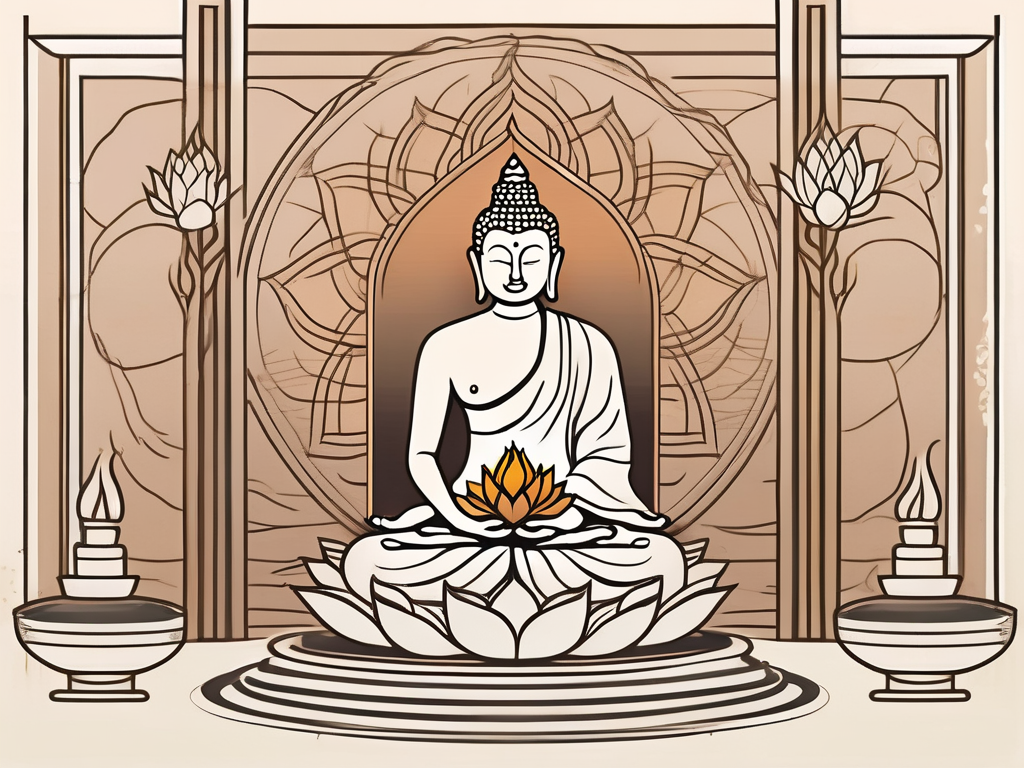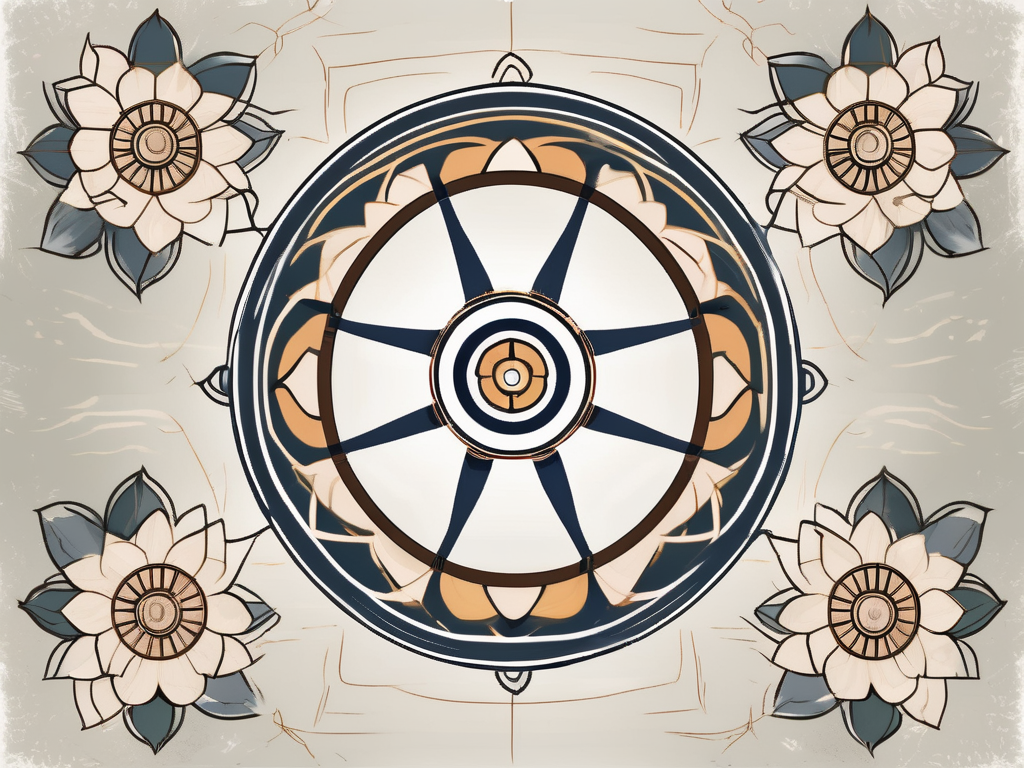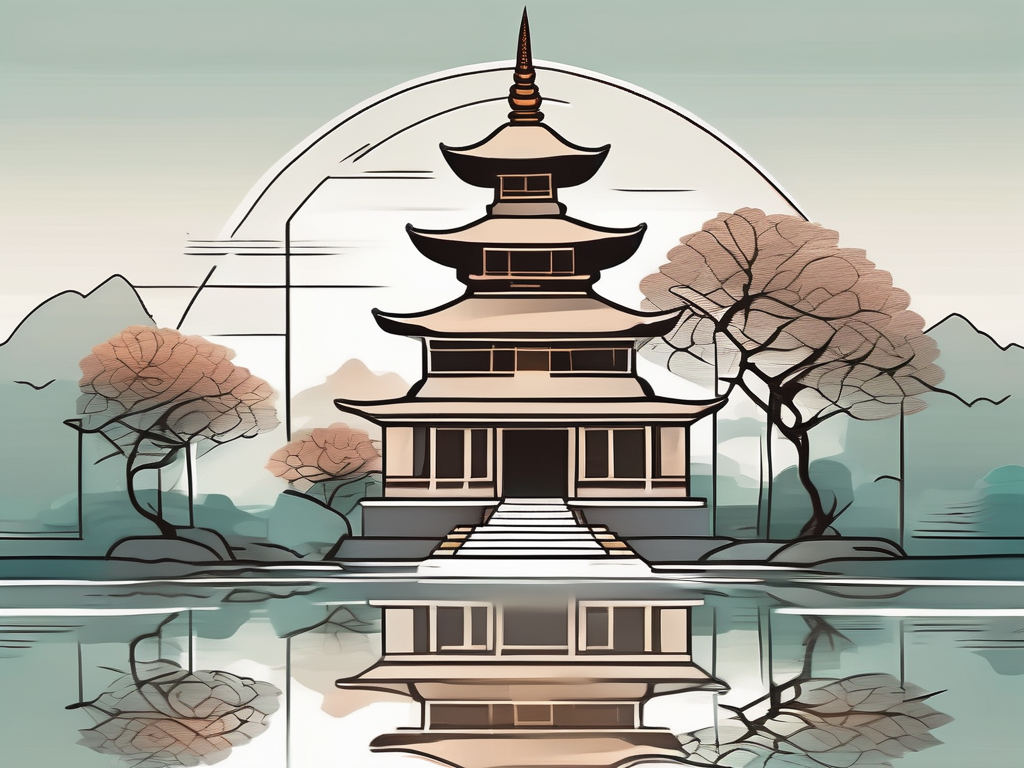Buddhism, one of the world’s major religions, is known for its unique philosophy and teachings. While Buddhism is primarily focused on personal enlightenment and finding inner peace, it also encompasses a variety of celebrations and festivals. These occasions play an important role in the lives of Buddhists around the world, serving as opportunities for religious expression, community engagement, and reflection.
Understanding the Buddhist Philosophy
In order to fully grasp the significance of Buddhist celebrations, it is essential to delve into the core beliefs of this ancient tradition. Buddhism rests upon several key principles, including the Four Noble Truths and the Eightfold Path. The Four Noble Truths convey the nature of human suffering and the path to liberation, while the Eightfold Path presents a comprehensive guide for cultivating ethical conduct, mental discipline, and wisdom.
Central to the Buddhist philosophy is the understanding that all existence is characterized by impermanence, suffering, and the absence of a permanent self. Buddhists strive to overcome suffering by relinquishing attachment and desire, fostering compassion and mindfulness, and ultimately achieving Nirvana – a state of enlightenment and liberation.
The Core Beliefs of Buddhism
At the heart of Buddhism lie three fundamental aspects: the Buddha, the Dharma, and the Sangha. The Buddha refers to Siddhartha Gautama, the historical figure who attained enlightenment and became the enlightened one. The Dharma encompasses the teachings and doctrines of Buddhism, elucidating the path to spiritual awakening. Lastly, the Sangha represents the community of Buddhist practitioners who support and guide each other along their individual journeys.
The Buddha, also known as the “awakened one,” serves as an inspiration for Buddhists worldwide. Siddhartha Gautama’s journey from a life of luxury to one of renunciation and self-discovery resonates deeply with those seeking spiritual enlightenment. His teachings, known as the Dharma, provide a roadmap for individuals to navigate the complexities of existence and find inner peace.
Within the Buddhist community, the Sangha plays a crucial role in fostering a sense of belonging and support. Practitioners come together to share their experiences, seek guidance, and engage in collective meditation. The Sangha acts as a source of inspiration and encouragement, reinforcing the commitment to the Buddhist path.
The Role of Celebration in Buddhism
While Buddhism emphasizes the importance of personal practice and self-transformation, celebrations provide an opportunity to come together as a community, express gratitude, and commemorate significant events in Buddhist history. These festivities enable Buddhists to deepen their understanding and commitment to the teachings, expanding their spiritual growth in a collective setting.
Buddhist celebrations vary across different traditions and regions, but they often involve rituals, prayers, and offerings. One such celebration is Vesak, also known as Buddha Purnima or Buddha Day, which commemorates the birth, enlightenment, and passing away of the Buddha. During Vesak, Buddhists engage in acts of generosity, meditation, and reflection, honoring the life and teachings of the Buddha.
Another important celebration in Buddhism is the Kathina Ceremony, which takes place after the end of the rainy season retreat. During this ceremony, laypeople offer robes and other requisites to the monastic community as a gesture of support and gratitude. The Kathina Ceremony symbolizes the connection between the monastic and lay communities, highlighting the interdependence and mutual support within the Buddhist tradition.
Throughout the year, Buddhists also celebrate various Bodhisattva and deity festivals, such as the Avalokiteshvara Festival or the Medicine Buddha Festival. These festivals provide an opportunity to invoke the blessings and guidance of specific enlightened beings, seeking their assistance in overcoming obstacles and cultivating positive qualities.
By participating in Buddhist celebrations, individuals deepen their connection to the tradition, strengthen their sense of community, and draw inspiration from the collective energy of fellow practitioners. These celebrations serve as reminders of the transformative power of the Buddhist path and the potential for awakening that lies within each individual.
Major Buddhist Celebrations
Throughout the year, Buddhists partake in various celebrations that honor significant events in the life of the Buddha or commemorate key milestones in Buddhist history. These occasions serve as essential reminders of the timeless wisdom and compassion embodied by the Buddha and inspire individuals to follow in his footsteps.
Buddhism, with its rich history and diverse traditions, has given rise to a multitude of celebrations that are observed by millions of followers around the world. These celebrations not only provide an opportunity for Buddhists to come together in community but also offer a chance for individuals to deepen their understanding and practice of the Buddha’s teachings.
Vesak: The Buddha’s Birthday
Vesak, also known as Buddha Purnima or Wesak, is perhaps the most widely recognized Buddhist celebration worldwide. It marks the birth, enlightenment, and passing away of the historical Buddha. On this auspicious day, Buddhists gather at temples adorned with vibrant decorations, offering prayers, meditating, and engaging in acts of generosity and charity to honor the Buddha’s teachings.
The celebration of Vesak is not limited to a single day but often extends over a period of time. It is a time for Buddhists to reflect on the life and teachings of the Buddha, contemplating the profound impact he has had on the world. In addition to the religious observances, Vesak is also a time for cultural festivities, with parades, lantern processions, and traditional performances taking place in many Buddhist communities.
Bodhi Day: Celebrating Enlightenment
Bodhi Day celebrates the moment when Siddhartha Gautama, sitting under the Bodhi tree, attained enlightenment and became the Buddha. Buddhists honor this event by meditating, studying scripture, and engaging in acts of kindness and compassion. Decorated Bodhi trees, often adorned with colorful lights and ornaments, symbolize the illumination of wisdom.
During Bodhi Day, Buddhists reflect on the significance of the Buddha’s enlightenment and strive to cultivate their own spiritual awakening. It is a time for deep introspection and self-reflection, as individuals contemplate the nature of suffering and the path to liberation. Many Buddhists also use this occasion to renew their commitment to the practice of mindfulness and compassion, seeking to bring these qualities into their daily lives.
Asalha Puja Day: Commemorating the First Sermon
Asalha Puja Day, also known as Dhamma Day, commemorates the occasion when the Buddha delivered his first sermon, known as the Dhammacakkappavattana Sutta. Buddhists pay homage to this event by visiting temples, participating in religious ceremonies, and listening to teachings on the Dharma. It is an opportunity for individuals to reflect on the profound impact of the Buddha’s teachings on their own lives.
On Asalha Puja Day, Buddhists come together to honor the wisdom and insight contained within the Buddha’s first sermon. They contemplate the Four Noble Truths and the Eightfold Path, which form the foundation of Buddhist practice. This day serves as a reminder of the transformative power of the Dharma and encourages individuals to deepen their understanding and application of these teachings in their daily lives.
Asalha Puja Day is also a time for Buddhists to express gratitude to their teachers and spiritual guides, acknowledging the role they play in transmitting the teachings of the Buddha. It is a day of reverence and appreciation for the lineage of wisdom that has been passed down through generations.
Regional and Cultural Variations in Buddhist Celebrations
Buddhism has spread across various regions of the world, adapting to local cultures and practices. As a result, different countries and regions have developed their own unique Buddhist celebrations, infused with traditional customs and rituals.
These regional and cultural variations in Buddhist celebrations not only reflect the diversity of Buddhist practices but also highlight the rich tapestry of human experiences and expressions of faith. From the vibrant colors and ornate costumes of Tibetan Buddhist festivals to the solemn rituals and ancestral reverence of Japanese Buddhist celebrations, each tradition offers a unique lens through which to explore the teachings and principles of Buddhism.
Tibetan Buddhist Festivals
Tibetan Buddhist celebrations are characterized by vibrant colors, ornate costumes, and intricate rituals. The most well-known festival is Losar, which marks the Tibetan New Year. This joyous occasion involves ceremonies to purify negativity, monastic dances, and the creation of elaborate butter sculptures.
During Losar, the streets of Tibetan communities come alive with the sounds of traditional music, the aroma of incense, and the sight of people dressed in their finest attire. The butter sculptures, meticulously crafted by skilled artisans, depict deities, auspicious symbols, and scenes from Buddhist mythology. These sculptures are not only a visual feast but also serve as offerings to the enlightened beings, symbolizing the practitioners’ devotion and aspiration for enlightenment.
Japanese Buddhist Celebrations
Japanese Buddhism encompasses a diverse array of festivals, with Obon being among the most prominent. Obon is a time when families gather to honor the spirits of their ancestors through rituals, folk dances called Bon Odori, and releasing floating lanterns or lighting small fires to guide the spirits back to the spirit world.
The Obon festival is a time of reflection, remembrance, and gratitude. Families clean and decorate their ancestral graves, offering food, flowers, and incense to their departed loved ones. The Bon Odori dances, performed in traditional costumes, are a way to express joy and celebrate the interconnectedness of past and present. The sight of lanterns floating on rivers or small fires flickering in the night sky creates a serene and ethereal atmosphere, symbolizing the journey of the spirits back to the realm of the ancestors.
Southeast Asian Buddhist Festivals
In Southeast Asia, Buddhist celebrations showcase a blend of religious traditions and cultural practices. The Songkran festival in Thailand, for example, marks the traditional Thai New Year, where water is splashed to symbolize purification and renewal. Loy Krathong, another significant celebration, involves floating beautifully decorated baskets down rivers to pay respects to water spirits.
Songkran is a time of joyous celebration and spiritual rejuvenation. People engage in water fights, throwing water at each other as a way to cleanse the past year’s misfortunes and welcome the new year with a fresh start. The streets become a playground of laughter and camaraderie, as locals and tourists alike participate in this exuberant water festival.
Loy Krathong, on the other hand, is a more serene and contemplative celebration. The floating baskets, known as krathongs, are made from banana leaves and adorned with flowers, candles, and incense. As the krathongs drift along the rivers, people make wishes and offer prayers to the water spirits, expressing gratitude for the life-giving force of water and seeking blessings for the future.
These examples of Tibetan, Japanese, and Southeast Asian Buddhist celebrations are just a glimpse into the vast array of cultural expressions within Buddhism. Each celebration carries its own unique significance and serves as a reminder of the universal human quest for meaning, connection, and spiritual growth.
Rituals and Practices During Buddhist Celebrations
At the core of Buddhist celebrations lie various rituals and practices that provide a deeper connection to the teachings and a greater understanding of oneself and the world.
The Importance of Meditation
Meditation holds a central place in Buddhist practice and is particularly emphasized during celebrations. By cultivating mindfulness and concentration, meditation allows individuals to calm their minds, develop insight, and deepen their spiritual experiences.
During Buddhist celebrations, meditation takes on a heightened significance. As practitioners gather together, they create a collective energy that enhances the power of their individual meditation practices. The serene atmosphere, filled with the soft glow of candlelight and the subtle fragrance of incense, envelops the participants, creating a conducive environment for deep introspection and self-discovery.
Within the realm of meditation, various techniques are employed during celebrations. Some practitioners engage in breath-focused meditation, where they observe the natural rhythm of their breath, allowing it to anchor their attention and bring them into the present moment. Others may practice loving-kindness meditation, where they cultivate feelings of compassion and goodwill towards themselves and all beings, extending their well-wishes to the entire world.
The Role of Chanting and Prayer
Chanting and prayer help Buddhists create a serene and focused atmosphere, fostering a sense of devotion and connection. By reciting sacred texts, such as sutras or mantras, individuals immerse themselves in the transcendental wisdom of the Buddha and invoke the qualities of compassion, wisdom, and liberation.
During Buddhist celebrations, the air resonates with the melodious sound of chanting. The rhythmic cadence of the voices, harmonizing in unison, creates a powerful vibration that permeates the space and touches the hearts of those present. The words of the sutras, rich with profound teachings, are chanted with reverence and devotion, invoking a deep sense of awe and inspiration.
Prayer, too, plays a significant role in Buddhist celebrations. As individuals offer their prayers, they express their heartfelt aspirations for the well-being and happiness of all beings. Through prayer, Buddhists cultivate a sense of interconnectedness and recognize their responsibility to contribute to the welfare of the world. The act of prayer becomes a transformative practice, aligning one’s intentions with the noble qualities of the Buddha and generating positive energy that ripples out into the universe.
Offerings and Almsgiving
Offerings and almsgiving are practices rooted in generosity and selflessness. Buddhists offer flowers, candles, incense, and food to the Buddha or monastic community during celebrations as a symbol of reverence and gratitude. This act also cultivates the spirit of giving and supports the sustenance of the monastic sangha.
During Buddhist celebrations, the act of making offerings takes on a deeper meaning. As individuals carefully arrange flowers in elegant vases, light candles, and burn incense, they do so with utmost mindfulness and intention. Each gesture is imbued with a sense of reverence and gratitude, symbolizing the offering of one’s own virtues and merits to the Buddha and the sangha.
Almsgiving, too, holds a special place during celebrations. Buddhists offer food and other necessities to the monastic community, recognizing their role as spiritual guides and guardians of the teachings. This act of generosity not only supports the material needs of the monastics but also serves as a reminder of the interdependence between the lay community and the monastic sangha. It is a tangible expression of gratitude for the guidance and inspiration received from the monastics, as well as a way to accumulate merits for oneself and all beings.
In conclusion, Buddhist celebrations hold deep significance for adherents of this ancient tradition. They bring communities together, enable individuals to deepen their spiritual connection, and strengthen their commitment to the teachings. Whether commemorating the Buddha’s life, celebrating enlightenment, or engaging in practices that foster self-transformation, Buddhists embrace these occasions as milestones along their path towards self-discovery and ultimate liberation.












